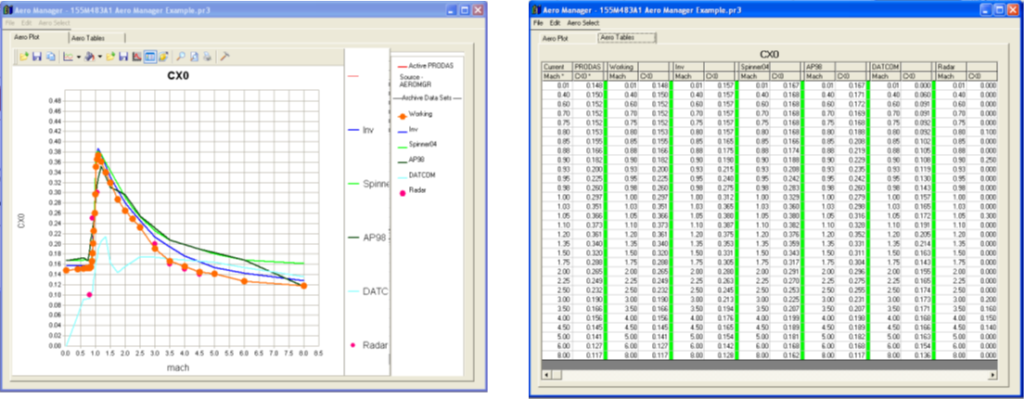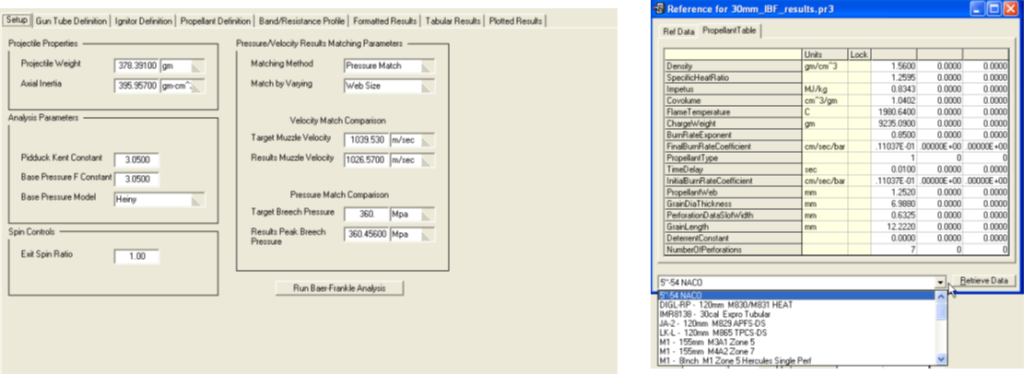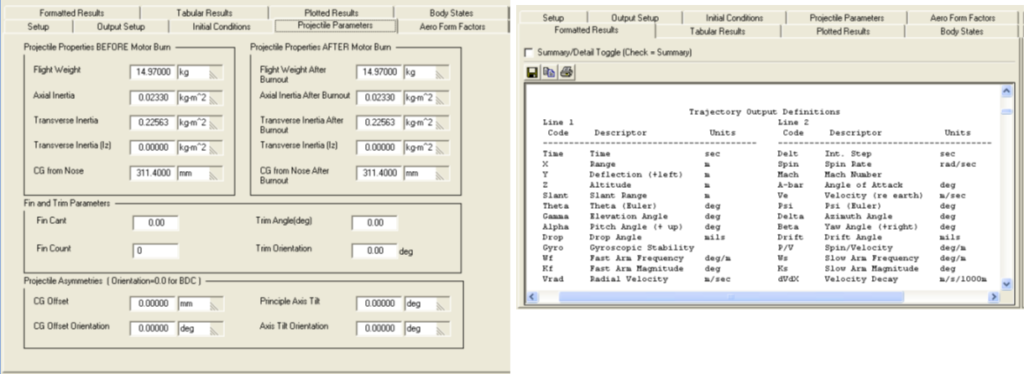Additional Library Rounds
- Additional projectile data files can save you time and money when beginning new designs or evaluating existing
- The basic PRODAS V3.5 analysis system is shipped with 22 inventory rounds.
- These files were created from known technical data and where available, actual aerodynamic coefficient data is included and supersedes the SPINNER or FINNER predictions. Known interior ballistic performance at ambient is also in the data file, providing the user with baseline launch environments.
- Additional optional rounds are available from Arrow Tech with the same known performance “hard-wired” into the data file.

Analysis BOT
Analysis (Ro)BOT
Create Macro Scripts automatically with the Analysis BOT. Using the Analysis BOT interface designate the projectile models, desired analysis, input variables, and desired output. The Analysis BOT will then automatically generate the Macro Script. The user can then save the Analysis BOT workbook or Macro Script for future changes or customization. The script can be accessed in the future via the “Tools” menu. The Analysis BOT is included with any of the Gun System Effectiveness modules or can be purchased separately.
- Access any analysis module within PRODAS
- Iterate the analysis by changing one or more inputs/projectiles
- Generate outputs including cross plots, summary tables and text outputs.
- Automatically generates script files that can be saved, modified and then rerun later
Select an Analysis Module
- All analysis modules enabled on your machine will be contained in the drop-down list box
- Select the module you want to exercise
Select one or more PR3 files
You can;
- Iterate on a single projectile, changing inputs
- Iterate on different projectile files
- Combination of both
- Browse the projectile of interest
- Enter unique comments
- Click on the “Add” button.
- The Comment will be added to help identify the run
- You can uncheck a run to temporarily remove it from the execution


- As a by-product of executing the BOT, a macro is produced
- You can save it for later use
- Run it from the “Tools/Edit-Run VB Script” from the main menu
Initial Conditions Generator
Aero Manager
Different aerodynamic estimation algorithms will produce different sets of aerodynamics. Each algorithm has its strengths and weaknesses, for example, one may do a good job on drag, but another does better on normal force. But each will develop a complete set of aerodynamics. Add to this aero data generated during testing and one can quickly become overwhelmed with numbers.
The PRODAS Aero Manager was developed to help the aero ballistician manage this potential mountain of aerodynamic data.
Aero coefficients from different sources are cross-plotted against each other. Experimental data can be added in as well. The user can then use any source as a starting set and then change all points or even individual points to better fit their engineering judgment. These modified tables can then be used to drive the other PRODAS analyses.
The Aero Manager is included at no charge when you purchase an option aero estimation code such as MISL3.
- Multiple sources can be analyzed within the Aero Manager
- DATCOM
- Spark Range
- Zeus
- CFD
- Wind Tunnel


Interior Ballistics
Contains both Empirical Database and Numerical Integration Interior Ballistics routines
- Empirical Database
- Based on 5 million 50 Caliber test firings at Frankfort Arsenal
- Numerical Integration IB (Modified Baer Frankle)
- Interior Ballistics analysis calculates velocity, breech & base pressure, and linear and angular accelerations of the projectile during travel down the tube.
- The analysis uses a modified Baer-Frankle method for simulating interior ballistics.
- The analysis will analyze cylindrical, spherical & flake propellant geometries.
- You can use the interior ballistics analyses to trade off propellant weight versus projectile weight, investigate the band wear effects of different barrel twists, and even estimate the effects of propellant blending.
- The Interior Ballistics analysis calculates the velocity, breech, and base pressure, and linear and angular accelerations of the projectile during the travel down the barrel.
- A simplified Interior Ballistics analysis is available that is derived from the Baer – Frankle method for predicting interior ballistics, examining the burning of the individual propellant grains.
- Or, if you prefer, PRODAS V3.5 has a user-friendly interface for IBHVG-2.
Reference libraries are provided with detailed information on propellant geometry and burn characteristics as well as igniter and gun parameters.


Rocket Firing Tables
- Purpose – Enable PRODAS users to produce key tables in NATO STANAG 4119 format
- •Trajectory Code – Modified Point Mass Model similar to the ARL model
- Tables Currently Available
- Artillery (F and G)
- Direct Fire
- Mortar (D and E)
- LOS Air Marine
- Rocket Firing Tables (Ballistic) Utilizes 6DOF for thrust phase)
- Accurate angular motion due to winds


- 6 DOF Body Fixed Trajectory with Launcher Routine
- Calculates Launch velocity, gravity drop and launch angular rates
- Based on user input thrust curves
- Utilized in Rocket Firing Tables/Rocket System Simulation

Terminal Effects
PRODAS V3.5 has a complete computational suite to assess the terminal effectiveness of warheads. Armor penetration of kinetic energy penetrators, and the fragmentation of high explosive warheads, can all be easily, quickly, and accurately assessed.
- Calculates V50 and R50 for armor penetration
- Bal66 Algorithm for penetrator L/D lower than 7
- Lambert Algorithm for penetrator L/D over 7
- Monolithic Armor
- BAL66 Allows Brinell Hardness input
- RHA and Aluminum assess in Lambert Algorithm
- Multiple Obliquity Angles
- Calculates Fragmentation for HE and HEI projectiles.
- Fragment weight
- Throw velocity

Kinetic Energy Projectile Penetration
Select from two closed-form penetration prediction algorithms based on the penetrator length-to-diameter ratio:
- BAL-66: L/D up to 10:1
- Lambert: L/D up to 30:1
High Explosive Fragmentation
Gurney-Mott-Sarmousakis methodology to predict the fly-off velocity, spray angle, and fragment mass distribution of naturally fragmenting projectile bodies.
3D Visualization with Scene Generator
Generate visuals of your model in 3D solids. Position the model in any orientation, section it, and produce movies of your projectile in flight. Simulated firing ranges, gunner, and target images are provided to increase the impact of these movies. The 3D Visualizer has the ability to animate projectile motion in flight.
- Quickly render 3D representation of Projectiles
- Cut away Views
- Visualize Trajectories
- Full Shooter to Target Videos

Projectile Tracing Tool
Whether the image comes from the Web, a brochure or a photo-graph of a sectioned projectile, you can now quickly build an accurate PRODAS model with a couple of clicks of the mouse.



Firing Tables
- The Firing Table analysis is intended to calculate provisional firing tables for situations where standard Firing Tables are not available.
- The analysis methodology used to calculate the trajectory is a Modified Point Mass Trajectory code.
- In this module, a series of trajectories over a range of elevation angles and a range of parameters (i.e., winds, muzzle velocity, etc.) are computed and the point of impact, impact conditions, and culmination location is saved.
- Once the Firing Table analysis is complete, either tabulated or plotted output is available.
- Create Firing Tables for the following weapons
- Direct Fire
- Howitzer
- Mortar
Firing Tables, including sensitivity factors, can be generated easily in minutes.
- Other Firing Tables Available:
- Line of Sight
- Line of Sight Air/Marine
- Artillery System Analysis


Purpose – Enable PRODAS users to produce key tables in NATO STANAG 4119 format
- Trajectory Code – Modified Point Mass Model similar to the ARL model
- Tables Currently Available
- Artillery (F and G)
- Direct Fire
- Mortar (D and E)
- LOS Air Marine
- Rocket Firing Tables (Ballistic) Utilizes 6DOF for thrust phase)
- Accurate angular motion due to winds
Body Fixed 6 DOF Trajectory
Along with the 4 and 6 degrees of freedom fixed plane trajectory simulations (The projectile rotates within the axis system), PRODAS also has 6 Degree of freedom Body Fixed simulation modules. In the body fixed trajectories, the projectile axis rotates with the projectile allowing simulation of asymmetric physical properties (Cg offset and Principle axis tilt), trim angles, and the resulting launch and downrange effects. Outputs include the standard trajectory output and the body states of the projectile.
Additional options include rocket launcher simulation where the launch-er parameters such as launcher diameter, launcher length, release détente force, rocket bourrelet length, and total rocket length are input. This algorithm then calculates the launcher velocity, spin generated by the input thrust vs. time curve or launcher rifling, and angular motion at exit caused by gravity drop. These exit conditions are then transferred to the initial conditions of the Body fixed 6DOF to continue the flight simulation down-range.


Software Development Kit
Now use our own software development tools to efficiently integrate your in-house developed analyses with PRODAS V3.5
Customize PRODAS for your business with the Software Development Kit
- Integrate your own proprietary analysis with PRODAS.
- Use the same tools Arrow Tech used to develop PRODAS.
- New modules appear on the menu, and use mass properties, aerodynamics, or any of the data contained in the PRODAS data file.
- Present results as text or plots, send data to cross plots, or even use the visualizer to display results.
- Outputs of your new analysis will be saved as part of the Projectile File.
Three tools are provided with the Software Development Kit
- Data Manager – This tool manages the data that is contained in the PRODAS data file. When you add your own analysis, chances are there will be setup data that you will want stored in the PRODAS data files along with the regular data. The expandable architecture design of the data file allows for user-defined data without impacting other analysis modules.
- Analysis Manager – This tool defines and actually codes (in FORTRAN) the interface between the main PRODAS application, which contains the user interface, and your analysis module.
- Form Manager – This is the tool used to build the user interface for a new analysis. Everything is done with a drag-and-drop editor making it easy to build the required input and output windows. You define the data your user enters and what output they are presented with. Text files, spreadsheet tables, or plots are quickly included in the interface with no coding required.
- User Interface development without coding
- All unit conversions are handled by the main menu
- Presentation Level Graphics
- Scientific Plots
- Projectile Model Display
- Cross Plots
- 3D Visualization
- Easy interface with Reference Books
- Natural for Sequential analysis
- Analysis #1 Results -> Analysis #2, Results -> Analysis #3
- Macro capability can automate repetitive tasks
MISL 3 Aero Prediction Code, Missile Datcom & AP 98
Multiple sources can be analyzed within the Aero Manager
- DATCOM
- MISL3
- Spark Range
- Zeus
- CFD
- Wind Tunnel

